Building of the Day: 651 Fulton Street
Brooklyn, one building at a time. Name: Originally Majestic Theatre, now BAM Harvey Theatre Address: 651 Fulton Street Cross Streets: Rockwell and Ashland Places Neighborhood: Fort Greene Year Built: 1904 Architectural Style: Beaux-Arts Architect: John B. McElfatrick Other works by architect: New Victory Theater, Manhattan, Brooklyn College of Pharmacy, Nostrand Avenue, Bed Stuy. Closed /demolished…

Photo via The Palette
Brooklyn, one building at a time.
Name: Originally Majestic Theatre, now BAM Harvey Theatre
Address: 651 Fulton Street
Cross Streets: Rockwell and Ashland Places
Neighborhood: Fort Greene
Year Built: 1904
Architectural Style: Beaux-Arts
Architect: John B. McElfatrick
Other works by architect: New Victory Theater, Manhattan, Brooklyn College of Pharmacy, Nostrand Avenue, Bed Stuy. Closed /demolished theaters include Montauk Theater, Gotham Theater, Loew’s Bijou Theater Brooklyn, Harlem Opera House, Metropolitan Opera House, Philadelphia, and many more.
Landmarked: No
The story: John Bailey McElfatrick was one of New York’s premier theatrical architects at the turn of the 20th century. He and the firm he founded with his sons, designed some of Manhattan and Brooklyn’s finest theaters, all built at a time when live theater was at its most popular, and vaudeville and variety shows were king. Along with his closest competition, architect Thomas W. Lamb, McElfatrick designed elegant theaters in all of the many different neighborhoods of New York. Almost every neighborhood had at least one theater, and some, like Downtown Brooklyn, had an entire district.
Brooklyn’s theater district had begun further up Fulton Street, near where Borough Hall stands today, way back in the 1850s. But by the turn of the 20th century, most of the theater activity had shifted to the area near Fulton Street and Flatbush Avenue, with theaters on Flatbush, Fulton, Lafayette and the other streets in that area. By 1920, this area rivaled Manhattan’s theater district, with large theaters providing a multitude of entertainment choices. One could watch a drama, Shakespeare, opera, vaudeville, musical comedy or melodrama. Plus many theaters were beginning to show films, as well. It was entertainment heaven.
J.B. McElfatrick’s first Fulton St. theater was the Montauk, built in 1895 for developer William Reynolds. It was on the corner of Fulton and Flatbush. He also designed Reynolds’ palatial mansion on Eastern Parkway in Prospect Heights, which is long gone. Fulton Street soon saw several more huge theaters soon after, Frank Freeman’s over the top Orpheum Theater, in 1900, followed by this theater in 1904, and Thomas Lamb’s Strand theater, right next door, in 1919. Only a block or so away, the large new Brooklyn Academy of Music rose in 1908, a new building to replace the venerable institution that had stood on Montague Street for many years before burning down. There were other theaters in the vicinity, as well.
As with most theaters, what you see from the street is only the lobby; the main part of the theater is in the back. The Majestic, as small as it looks from the front, had a seating capacity of 1,828. It opened with a venue of light operas, dramas, comedies, vaudeville and musicals. The opening production was “The Wizard of Oz.” As the years went by, it became an important trial theater for Broadway-bound productions. The theater changed hands in 1940, and began booking big bands and headliners like Glenn Miller and Sophie Tucker. In 1942, the theater was sold to Leon Siritsky and his two sons, Joseph and Salamon, wealthy Parisian showmen who had fled the Nazis in Europe. They changed the venue to an elegant European style first run movie palace, and installed air conditioning and new amenities to the theater.
But by the 1960s, the theater was no longer making money. In much the same way as movies had replaced a great deal of theater, television replaced movies, at least to the extent that many movie theaters no longer had enough steady business to stay open. Neighborhoods were also changing, as New York City entered a long period of abandonment to the suburbs, and an economic slump. Like a great many theater buildings, including the Strand next door, it closed its doors, in 1968. It would remain boarded up for over twenty years.
BAM’s director, Harvey Lichtenstein, was in the process of revitalizing that institution in the 1980s. He was interested in producing a 9 hour stage production of Peter Brook’s “The Mahabharata,” and thought this derelict building, so close to BAM itself, would be a perfect venue. He and Peter Brook actually got in by putting a ladder to a broken back window on the second floor. The plaster was falling, there was a lot of water damage, and the stage floor was crumbling. It was perfect.
The city was trying to revitalize Downtown Brooklyn, and they owned the building, so BAM and the city raised the funds and embarked on an award winning restoration of the theater, one of the first American ventures to incorporate the patina and condition of an abandoned theater with a state of the art new modern performance space. The seating was cut by half to around 900, creating a more intimate performance space. The restoration cost over $5 million. The new theater was opened in 1987, and renamed for Harvey Lichtenstein in 1999. It’s been the venue for many plays and performances ever since. Today, as of 2013, the theater once again shows films, on its new Steinberg screen, with Dolby sound, and all the bells and whistles. GMAP
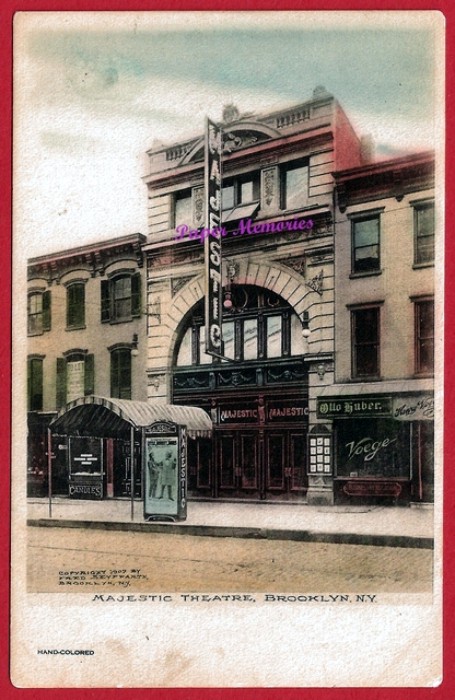
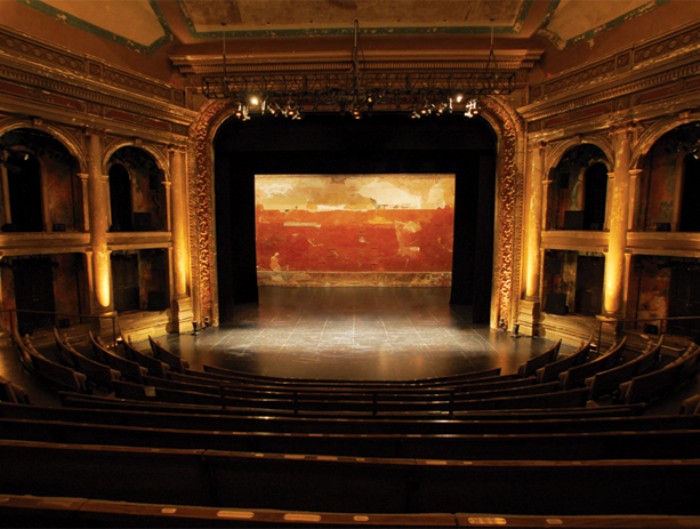
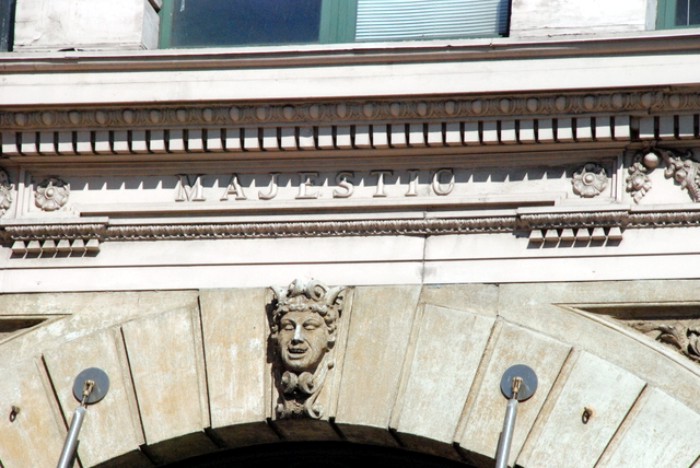
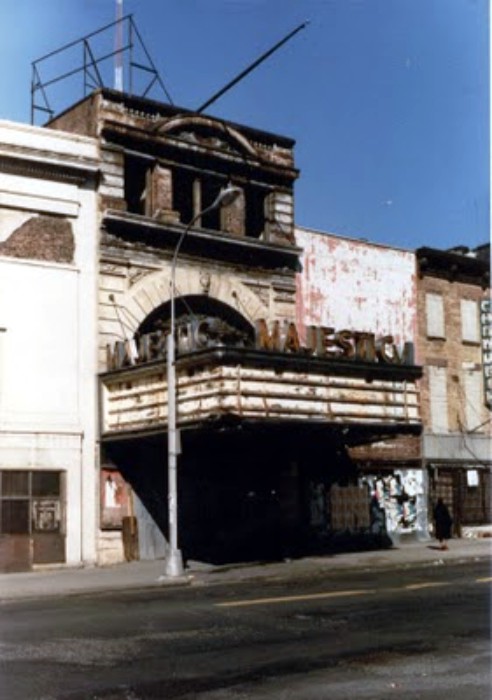
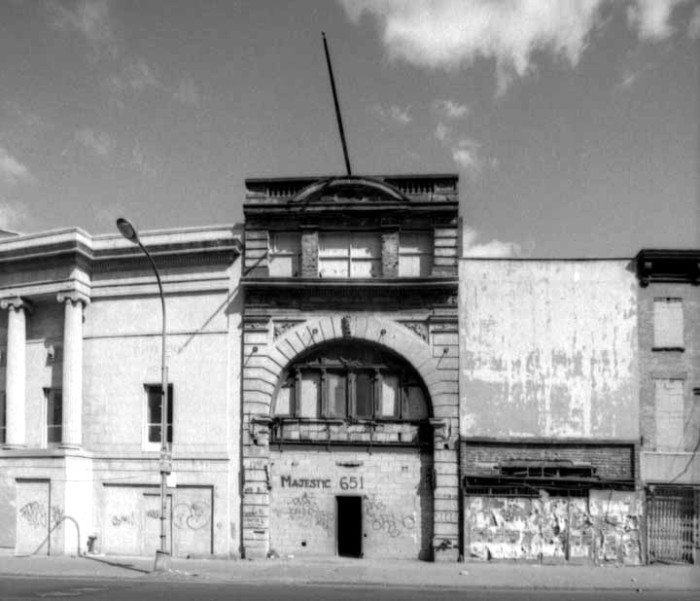





I’ve seen both Blue Jasmine and The Word’s End at the Harvey. I honestly did not find the seats uncomfortable at all. They are padded and wide and there is even a cup holder (no, not on the armrest). At any rate, I recommend the Harvey for those who looking to see a movie under ideal conditions.
Hmmm… in your BAM’s history part of this story, there should be some credit here going to Judith Daykin, past Exec.VP and Managing Director at BAM. She served as President of the League of Historic American Theaters and was a big part of the search for additional theater space for BAM. At the time of that search, there were a few options besides the Majestic, including the old Terminal Theater (now the Universal Church) and the Strand among others.
And yes, they are showing films at the “Harvey”… and the seats ARE the most uncomfortable I’ve ever known! Though be thankful Brooks didn’t get his way… he wanted only benches!
What a joy to have a real theater to see a film in! Big screen! Perfect Sound! Wide Comfortable seats! Great Sight-lines! Way to go BAM.